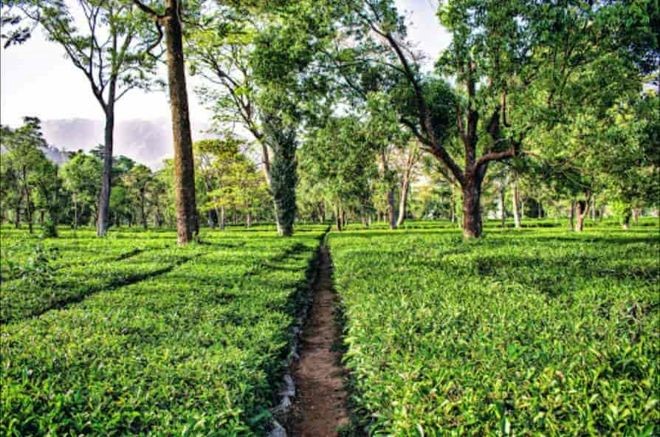Description

Disclaimer: Copyright infringement not intended.
Context
- Himachal Pradesh's Kangra Tea got a European Union Geographical Indication Tag (GI tag).
Significance
- The tag will help Kangra tea to get an opportunity to enter the European market. Kangra tea received the Indian GI tag in 2005.
Note: Since 1999, the cultivation and development of tea have improved constantly in the Kangra region of Himachal Pradesh.

Kangra Tea
About
- 'Kangra tea' is a type of tea derived from the leaves, buds and tender stems of the Camellia sinensis species as cultivated in the Kangra valley of Himachal Pradesh.
Characteristics
- 'Kangra tea' leaves' main characteristics are: a multi-stemmed frame, and narrow leaves.
- 'Kangra tea' is planted from seed stock raised in the Kangra valley and other selected varieties for the region.
- 'Kangra tea' has distinctive nutty, winter-green, woody floral aromas in its flavour profile.
- The 'Kangra tea' imparts a sweet aftertaste. 'Kangra tea' has a light colour and high body in liquor.
- 'Kangra tea' leaves contain up to 13 per cent catechins and up to 3 per cent caffeine and amino acids such as theanine, glutamine, and tryptophan.
Types
- The teas produced in the Kangra Valley are green, oolong, white and orthodox black types.
- 'Kangra tea' is produced using high efficiency whole leaf-orthodox manufacture which means that 'Kangra tea' is made up of whole leaf and flavour-enriched leaves with the highest content of polyphenols (catechins).
Area of Production
- 'Kangra tea' is produced in several areas located on the slopes of the Dhauladhar mountain ranges of the Western Himalayas.
- These areas are Palampur, Baijnath, Kangra, and Dharmshala in the district of Kangra; Jogindernagar in the district of Mandi, and Bhatiyat in the district of Chamba.
Favourable conditions in Kangra Valley
- Altitude is one very specific feature of the area as all the tea plantations are set within the altitude range of 900 to 1400 m in the mountain ranges.
- The Kangra area also yearly receives high amounts of rainfall.
- The city of Dharmshala and its surrounding areas are indeed recorded to be the second highest rain-receiving areas after Mawsynram of Meghalaya state in India. The average rainfall at Dharmshala ranges between 270-350 cm per year.

Medicinal Properties of Kangra Tea
- Recently, Kangra green tea has attracted everyone’s attention after a few research paper’s release in which the result came out to be that Kangra green tea has extracts that are more helpful to cure covid-19 than the actual medicines.
- Breast cancer, colorectal cancer and prostate cancer risk seems to have been reduced more as compared to other cancers by consuming the special Kangra valley green tea.
- The catechin that is found in green tea extracts is highly effective in preventing cell damage and in providing other benefits because it is a natural antioxidant. Along with that it helps the brain function in place and increases fat burning in the body.
- The Kangra green tea is rich in so many health benefits, from brain to metabolism, from oral health to cancer prevention it has incredible special medicinal properties.
Read about Tea Industry in India: https://www.iasgyan.in/daily-current-affairs/tea-industry-in-india
Tea Tourism in India and its significance
- Tea tourism is slowly beginning to gain ground in and around Kangra.
- Tea tourism in India has become increasingly popular in recent years.
- Tea tourism typically involves visiting tea estates, learning about the tea production process, and sampling different varieties of tea. Many tea estates offer guided tours, where travellers can see the tea plucking, processing, and packaging. Some tea estates also offer activities such as tea-tasting sessions, tea-making workshops, and nature walks through the tea gardens.
- India is the best place for tea tourism because of its diverse landscape, which creates a unique tea culture. From the lush hills of Darjeeling and Assam to the picturesque Nilgiris in the south, each region produces distinct varieties of tea with their own flavours and aromas.
- Darjeeling, West Bengal – Darjeeling, known as the “Queen of the Hills”, is one of the most popular destinations for tea tourism in India. The region’s tea is known for its Darjeeling tea, which is produced in the high altitude tea gardens. Known as the “Champagne of Teas,” Darjeeling tea is famous for its unique flavor and aroma.
- Assam – Assam is one of the major tea-producing regions in India, and therefore a significant destination for tea tourism.
- Munnar – Munnar, located in the state of Kerala, is a popular destination for tea tourism.
- Nilgiris– The Nilgiris, located in Tamil Nadu, is a beautiful region famous for its tea estates. People know Nilgiri Tea for its unique flavor and aroma, and tea tourism is a popular activity in the region.
- Kangra Valley– Kangra Valley, located in Himachal Pradesh, is an emerging destination for tea tourism. Kangra tea growers produce high-quality tea in the region at an altitude of 1,000 to 1,800 meters above sea level. Moreover, Kangra Valley offers a unique blend of tea tourism with wellness tourism.
- Tea tourism has the potential to completely transform the tea-drinking experience by assisting us in intellectually understanding the origins, processing, and terroir of tea.
- Tea tourism in India has the potential to contribute to domestic tourism by attracting tourists from other parts of the country to visit tea-growing regions.
- Overall, tea tourism in India offers visitors the opportunity to learn about and experience the country's rich tea culture, while also enjoying the beautiful landscapes and natural beauty of the tea-growing regions.
- The importance of tea tourism in India is immense as it has a dual impact by creating a regional tea market and securing jobs for tea labour.
- Therefore, proper guidance for the tea tourists is essential regarding the tea tourism destinations by addressing the issues, challenges, and opportunities in promoting local culture.
- Through the public-private partnership, tea tourism should be included in the mainstream tour packages, and local tea customs can be conveyed through a variety of activities promoting sightseeing and other forms of entertainment and tourism experiences.
- A proper planning is required for making tea tourism more attractive and developed in India.
- Development of tea tourism sustaining the environment and preserving the heritage and culture will benefit the Indian regions by creating employment opportunities and boosting the rural economy and thereby alleviate the insurgency and other socio-economic problems.
- It is expected to contribute to the literature on tourist guiding and the promotion of tea tourism and the tourist guides within tea garden boundaries in India.
|
PRACTICE QUESTION
Q. The importance of tea tourism in India is immense as it has a dual impact by creating a regional tea market and securing jobs for tea labour. Elucidate.
|

https://www.tribuneindia.com/news/himachal/himachal-pradeshs-kangra-tea-gets-european-gi-tag-492392














